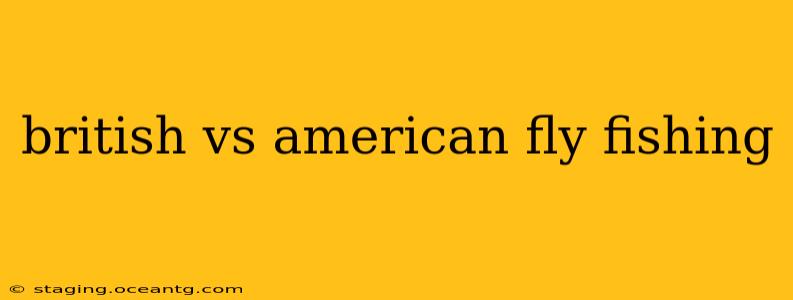Fly fishing, a sport steeped in history and tradition, boasts unique variations across the globe. This article delves into the fascinating differences between British and American fly fishing styles, exploring techniques, equipment preferences, and the overall angling philosophies that define each approach. While both share the fundamental goal of catching fish with artificial flies, subtle and significant distinctions set them apart.
What are the Key Differences Between British and American Fly Fishing?
This is a broad question that encompasses many aspects of the sport. The differences aren't always black and white, and many anglers blend elements from both styles, but generally speaking, some key distinctions emerge:
Water Types and Fish Species:
- British Fly Fishing: Often focuses on smaller, more technical rivers and streams, targeting trout (brown, rainbow, sea) and grayling. The emphasis is frequently on stealth and presentation in challenging, often densely vegetated waters.
- American Fly Fishing: While also featuring river fishing, it encompasses a broader range of environments, including larger rivers, lakes, and saltwater flats. Target species are diverse, including trout (various species), bass (largemouth, smallmouth), salmon (Atlantic and Pacific), bonefish, tarpon, and many more.
Fishing Techniques:
- British Fly Fishing: Traditionally favors more delicate presentations, often using lighter rods and smaller flies. Techniques like roll casting and precise upstream presentations are emphasized, focusing on subtlety to avoid spooking wary fish in close confines. Dry fly fishing is particularly prevalent.
- American Fly Fishing: Often employs more powerful techniques and equipment, catering to larger fish and more challenging conditions. Overhead casts, double haul techniques, and longer casts are common, enabling fishing in wider, more open waters. While dry fly fishing is present, nymphing and streamer fishing are equally popular.
Equipment:
- British Fly Fishing: Generally favors lighter, more flexible rods (typically 3-6 weight) designed for finesse. Reels are often smaller and more understated. Leaders and tippets are typically finer, prioritizing delicate presentation.
- American Fly Fishing: A wider range of rod weights is utilized (3-8 weight and even heavier for saltwater), reflecting the diversity of species and fishing conditions. Reels are often larger and more robust, capable of handling stronger fish and longer casts. Leaders and tippets can be heavier, depending on the target species and fishing environment.
Fly Patterns and Tying:
- British Fly Fishing: Known for its tradition of classic, subtle fly patterns that mimic the natural insects found in British waters. Many patterns are relatively simple in design and coloration.
- American Fly Fishing: Exemplifies a more diverse range of fly patterns, often incorporating more vibrant colors and unconventional designs, inspired by a wide variety of insects and fish food sources across different environments. Innovative and experimental fly tying is common.
What are the differences in fly fishing culture?
The cultural aspects surrounding fly fishing also diverge:
- British Fly Fishing: Often associated with a more traditional, almost ritualistic approach, emphasizing conservation and respect for the environment. The focus is often on the experience itself, the beauty of the surroundings, and the challenge of the angling.
- American Fly Fishing: While embracing conservation, exhibits a more diverse and dynamic culture, embracing both the challenge and excitement of the sport. Innovation and technological advancements are often embraced, as are diverse social aspects of the community.
What are the benefits of each approach?
Both British and American styles offer unique benefits. The British approach excels in finesse and stealth, perfect for highly pressured fish in technical environments. The American approach provides versatility, capable of tackling diverse species and conditions.
How do the two styles compare in terms of cost?
The cost can vary significantly depending on individual preferences and chosen equipment, but generally, the American style might involve a higher initial investment due to the broader range of equipment often employed.
Ultimately, whether you prefer the subtle elegance of British fly fishing or the diverse challenges of the American style is a matter of personal preference and angling goals. Both approaches offer a rewarding and engaging experience, showcasing the enduring appeal of this classic sport.
